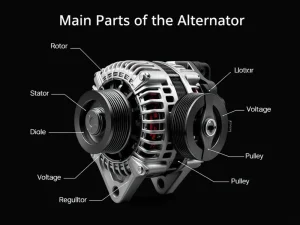Introduction
Before getting into the details of the parts of the alternator, here is the definition of an alternator: An alternator is a device that generates electrical energy from mechanical energy. These alternators are part of any combustion engine that can power the battery to start the car’s engine. Also, you can power and charge your car battery with the help of these alternators.
What Are the Components of an Alternator?
A combustion engine has an alternator containing two essential components: a rotor and a stator. These alternator parts are essential in generating the electromagnetic field, which rating generates with these parts. Slip rings, rectifiers, voltage regulators, clutch pulleys, Diode bridges, and bearings are also essential components of the alternator. Every part is explained as follows.
Rotor
The moving alternator part is called the rotor. The alternator has an electromagnetic part as it generates the electromagnetic field by rotating. This rotor has magnets that rotate around the stator’s plates to produce Alternating Current (AC). The alternator rotor works with the alternator stator to provide charge. The only cause that an alternator works when the engine is running is that the rotor needs an engine belt to spin it.
Stator
As the name indicates, the stator is the static alternator part and does not move. It consists of two parts: a laminated core and outer insulated windings. The rotor spins inside the windings to produce AC and create a rotating magnetic field. The stator is insulated as compared to the rotor because it contains high voltage.
Slip Rings
Slip rings are electromechanical devices that conduct signals from the rotor to the stators. They are mediums for getting DC power while providing power to the rotor. Slip rings are used in an alternator to improve and simplify mechanical operations.
Rectifier
A rectifier that converts the two-way flowing Alternating current AC into the one-way flowing Direct Current DC, is also an important component of the alternator. The rotor and stator produce AC that is of little use in systems like automobiles. An alternator requires a rectifier for its proper functioning.
Voltage Regulator
The voltage regulator provides a balance of voltage supply between the alternator and the electrical system. The alternator cannot control its voltage independently, so a voltage regulator is required to balance the voltage flow. It has two inputs and one output. It works as the voltage drops from the required level. It can strengthen the supply by regulating the strength of the magnetic field.
Clutch Pulley
An alternator in the car has a clutch pully attached to the shaft of the rotor and the drive belt. The clutch pully helps rotate the engine. The charging process starts as the power emerges from the drive belt to the clutch pully. When the engine is still, it works to provide enough power to maintain a battery charge.
Diode Bridge
The alternator contains a diode bridge. It is made of four diodes that act as a bridge rectifier. It converts the Alternating Current (AC) into the Direct current (DC) from the stator. The car batteries need to convert the AC into DC for functioning.
Bearings
The bearings in the alternator are also known as slip-ring end bearings. The end bearings provide support to the rotor shaft that will enhance the engine’s efficiency and decrease friction.
Input Shaft
A car alternator has an input shaft that is the central part of the rotor. The rotor rotates with the help of an input shaft that is used to convert rotational energy into electrical energy. The field current to the rotor is the output, while the inputs are the control voltage input and the field current supply.
How Does an Alternator Work
An alternator is a very complex device. Details regarding the components are already stated. These parts are arranged in an alternator assembly that works together for perfect functioning.
- Ignition is the starting point for powering a rotor battery.
- As the rotor spin increases, the engine speed rises in the alternator assembly.
- As the speed rises, the stator voltage rises.
- The voltage of the battery-charged voltage from the rectifier increases.
- The voltage regulator detects this increase in voltage.
- The voltage regulator works to reduce the voltage.
- And at the end, the stator voltage drops.
Conclusion
The alternator is a device used in car combustion engines. They are used to convert mechanical energy produced into electrical energy for usage. All the parts in the alternator have their importance. But the rotor and stator have their place because these two play essential roles in the working of the alternator in the car battery, or any other combustion engine.

